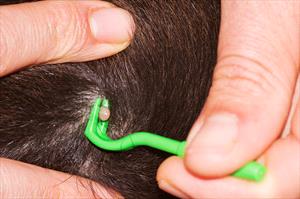Tick removal

Photo courtesy of Depositphotos
It’s that time of year when we turn around and face the tick, the whole tick, and nothing but the tick. When the temperature brings an alarming heat wave - that blasting furnace of 40°F - parkas and snow boots are flung into the closet and it’s time to learn all over again how to get those blasted ticks off your pets.
It matters not if your dog only moseys outside to do business before hobbling back in to watch tv with you; any animal that goes outside during tick season is liable to have a tick do a spring fling thing and attach its vicious little self. Little parasites should get a real job and quit freeloading off your dog.
So let’s begin. Your dog or cat has come inside. Once a day or so, at least during the heaviest time period of infestation for your geographic area, you run your hands allllll over the pet’s body, feeling here, feeling there. You find a little bump, you pull the hair away and examine it. Is it a nipple (boy dogs get them too, you know)? A fleshy bump that the vet should see? Or is it an attached tick?
Obviously, this search is much easier and faster with a short-coated pet, such as a Lab, pug, or domestic short hair cat. If you have a Newfoundland or a long-haired cat, this task is bound to take an extra minute or two.
Don’t forget to search beyond the basic torso, belly, head, and neck. Look at the places you don’t normally look at, such as in the ears, between toes, their not-so private parts, the armpits, and the legpits. Certainly, some tick searchers would refer to legpits as armpits, but whatever you call them, look at the underside where the leg joins the rest of the body.
Should you find a lump that is actually a tick engorging itself, it’s time to go into action. First, take care of yourself by wearing gloves. Lyme disease is much harder on people than on pets. You can use tweezers or a tick remover, but follow directions on the tick remover because there are several models on the market. What you do is the same no matter what tool you use.
Apply tool, pull parasite out, and listen to it scream for mercy. Ignore those pleas.
Here’s my favorite part: getting rid of the tick you just plucked, engorged or otherwise. You can drop it into isopropyl alcohol. If you don’t have any isopropyl alcohol and you do not have time to run to the store with an annoyed tick in your tweezers, use hot water mixed with dishwashing liquid. The alcohol is better.
There’s also stomping on it with your shoe while your foot is still in it, but that’s pretty gross unless you are outside. If it’s engorged you could engage in do-it-yourself splatter reading. Effective, but gross.
You don’t have to be a dog or cat for these to work. You can use pet tick-remover tools on yourself. Safety tip: check your own armpit.
Most tick bites don't spread disease, and they don't need to be treated. However, write down what date you found the tick, and where it was on your pet’s body. If your pet ends up with signs of a tick-borne disease, this information will help your veterinarian. Signs include lameness for a few days, lethargy, swollen joints, fever, fatigue, swollen lymph nodes, loss of appetite and neurological problems. Obviously, most pets will not get all of those signs.
Remember to clean your tool with isopropyl alcohol.
Ticks are sneaky and can transfer between hosts just because they feel like it, so it can jump from your dog to you to your cat.
It doesn't matter how sneaky ticks are, or what their life cycle is. You're in charge of keeping your pets on a preventive and doing the Icky Ticky Check. Your vigilence will keep your pets healthier.
You do not have permission to view this document: [9555625]!